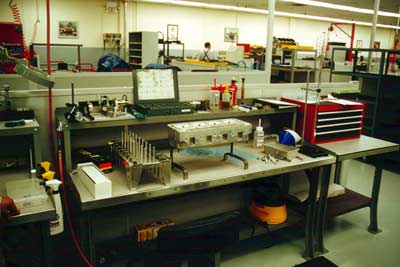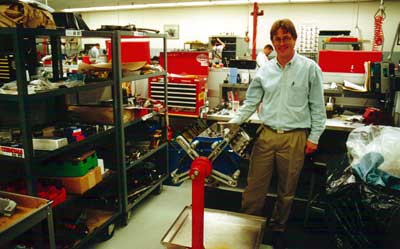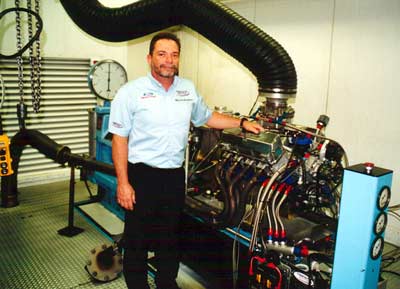INSIDE
RACING
T E C H N O L O G Y
IRT Home
IRT Home
News Page
Contents Page
Newsletter &
Books
email Paul
Cosworth NASCAR Engine

Most work benches in the engine build room at Cosworth Racing's Torrance, Calif. facility hold shiny, intricate, cast-aluminum parts for the turbocharged, methanol-fueled, V-8, CART Champ Car engines badged by Cosworth's parent, Ford Motor Co. But one of the work bays now has a different assortment of parts-massive compared to the Champ Car engine components. The cast-iron block mounted in the engine stand is a V-8, but it's dark and gray instead of brightly shiny and the crankshaft resting inside it is huge.
Instead of the jewel-like intake and exhaust valves in the CART heads, NASCAR valves are twice the diameter as the CART valves and are more than twice the weight. This weight difference is critical because valve train mass is the single most important factor in getting the engine to live at elevated rpm. NASCAR does allow titanium valves, retainers, and keepers but instead of four small valves per cylinder controlled by a direct-acting camshaft in the CART engine, the NASCAR "motor" has to use the same configuration as in the Ford vehicles sold for street use-two valves per cylinder operated by rocker arms and long pushrods. This engine is very different from the purpose-designed race engines in the surrounding work stalls. This is the engine Cosworth has begun to develop for the NASCAR Busch Grand National series.
New Development Group
"Ford wants Cosworth to help lift the performance of their lead NASCAR teams," explained Ian Bisco, Cosworth vice president and manager of the Torrance facility. "Right now there are only six or seven Ford teams competing in the Busch series. The rest of the field is Chevrolet or Pontiac. There's been a perception among Busch teams that the Ford engines are weak compared to the General Motors engines, especially at restrictor-plate races. Ford would like us to develop the engine and change that image. If more Busch teams are running Fords that's a better breeding ground for Ford's Winston Cup effort.
"NASCAR is totally new to us. We're working with Cal Well's McDonalds-sponsored Busch team. We wanted to work with a team that would be willing to try things and be flexible.

"And we've hired some good people to help us. Davis Jensen (in photo) comes from the Southern California aerospace industry to be our NASCAR program manager. Skip Wickersham worked for a NASCAR engine builder about six years ago and is our technical liaison to the teams. Chris Fox is the lead engine builder. Chris Robinson is based in North Carolina and takes care of track support.
"Bruce Wood is heading up the NASCAR program in the U.K in addition to being CART program manager. They've been involved for about four months and have some good ideas. Our engines are competitive now and towards the end of the year we might see some significant improvements. The McDonald's team and driver Anthony Lazzaro will get the first improved engines."
Good Results with Off-the-Shelf Components
NASCAR is billed as a "stock car" race series. But except for the roof and deck lid body panels, there aren't actually any stock parts in a NASCAR Winston Cup or Busch Grand National racecar.
Engine rules in the Busch series contain some very specific limitations on the actual parts that can be used. The design and dimensions of the engine block, heads, and intake manifold are tightly controlled. The connecting rods, crankshaft, and camshaft shapes are free but no exotic materials are allowed. The oil pan envelope is fixed but the internals are free except the oil pump itself must fit inside a certain shape.
"To start off our project we bought components that were readily available-nothing trick," explained Bisco. "Those first engines put out surprisingly good power without any development. That gives us confidence that some work on our part will produce good results. Now that we're a part of Ford we have access to their transient dynamometer in Dearborn. That's a powerful tool we look forward to using on this project."
Both the Busch and Winston Cup engines displace 358 cubic inches. Winston Cup engines are restricted to a 12 to 1 compression ratio while Busch rules mandate 9.5 to 1. The Busch carburetor is rated at 390 cubic feet per minute of flow, smaller than the Winston Cup carburetor rated at 830 cfm. An unrestricted Winston Cup engine supposedly develops almost 800 hp, but choked down to less than 450 hp by a restrictor plate with four orifices sized at 7/8 inch each. A smaller carburetor and lower compression ratio limits the Busch engine to a little more than 500 hp or 390 with a restrictor plate using four 31/32 inch openings.
"We bought several carburetors from different sources," Bisco said. "We took them to a race and had the NASCAR tech inspectors look at them. One of them failed. The guy said, 'Don't let me see that one on a car.' He measured one of the others and told us, 'That one's OK but don't even wipe it hard.' Those carbs cost about $1,500 each. The parts for an entire engine cost $30,000.
More Than Power
"Engine developers tend to focus on power but you have to think about other things also. Reliability is critical not just in a race but to maximize the track time for the team during a race weekend and during testing. But the engine needs to be easy to work on too.

"We've cleaned up the engine installation. We're using a smaller alternator than most teams use. We've designed the brackets to be nice and neat and reliable. The finished engine will have the valve covers painted "Ford" blue. A neat, attractive appearance adds to the image.
"We'll have a look at the oil system and see if we can
make some improvements," Bisco said. "And the crank,
rods, valves, valve train, and pistons. At least in the Busch
series we can use roller valve lifters. In Winston Cup engines
you have to use small diameter, flat lifters.
"Of course the restrictor-plate races at Daytona and Talladega
need a different engine. The restrictor plate puts a huge premium
on moving the valves quickly and keeping them open as long as
possible.

"NASCAR seems to welcome our involvement. They know the
Busch series would benefit from a more balanced participation
between Ford and GM. Dodge is coming into Winston Cup racing
next year and we're watching that carefully. I think Ilmor [Ilmor
Engineering designs and manufacturers the CART and Formula 1
engines entered under the name of Mercedes-Benz.] is involved
in the development of the Dodge engines.
"We've heard Dodge is trying to get approval of a high-cam,
short-pushrod engine design. We'd like to do the same thing,
of course. Maybe they'll break the ice for us.
"We've expanded here at Torrance because of the NASCAR project and the addition of another CART team. Forsythe Racing switched from Mercedes-Benz to Ford at the end of last season. We've got 67 people working here up from 52 last year."
Bruce Wood Involved in U.K.
Bruce Wood is an experienced Formula 1 engine designer and is the current Cosworth CART Program Director in addition to overseeing the U.K NASCAR effort. "The NASCAR engine is different for sure," Wood said. "But it uses steel valve springs like our CART engines and we've learned a lot about that. The valve train dynamics are very complicated in a pushrod engine. We'll let some of our young engineers have a go at it and see if they can make some significant improvements.
"We have a lot to learn about carburetors. And the current
engines generate some impressive loads on the pistons and connecting
rods. We possibly have some techniques that can be applied in
this area.
"Ford wants to move forward in the Busch series. They want
us to improve the specification of the Ford engine and make that
technology available to other Ford engine builders. We won't
be making and selling parts as we do for other race series.
"We have a lot of respect for the work done by the teams
and independent engine builders. They've lived with the mechanical
limitations of these engines for a long time and we're just getting
started. But this is a good opportunity for our engineering staff
in England to take a look at something new and different. They're
very excited about it, actually."
Attention to Detail
An internal combustion engine is basically a pump extracting energy from the working fluid, an air/fuel mixture. The engine pumps more fluid at higher rotating speeds providing the opportunity for more power output. Maximizing inlet and exhaust efficiencies, optimizing combustion, minimizing heat lost to the cooling system, and weeding out friction losses are some of the details that lead to power increases.Regardless of manufacturer the V-8 engines used in NASCAR racing have the intake and exhaust valves mounted parallel to each other in a relatively small combustion chamber. A portion of the piston top is flat and, at top dead center, this area comes very close to touching the flat surface of the head outside the combustion chamber. At the end of the compression stroke when the spark plug fires and the piston rises and almost touches the head surface, the resulting "squish" of the air/fuel mixture creates a powerful turbulence that greatly enhances combustion and retards detonation at high compression ratios.
Cosworth and, probably other engine builders also, make sure they maximize the squish effect with a special final machining operation. The clearance between the piston top and the head surface can vary due to tolerances in connecting rod length, block deck height, and piston pin location. After a trial assembly and measurement a final machining operation on the piston produces clearances no more than 0.002 inch greater than the minimum piston/head clearance Cosworth wants.
Comment:
As recently as five years ago NASCAR racing was spoken of as "low-cost." Not anymore! Sponsors show the value they receive from racing by tossing more and more money at the teams. With Daimler-Chrysler jumping into the NASCAR fray to go head to head with GM and Ford, direct sponsorship dollars might not increase but research and development budgets within those corporations are sure to inflate.
Winning is extremely important and keeping score on the competition between the car brands is a part of every TV show. We won't be able to see the war going on in the corporate engineering centers but, if one of the Big Three think they're at a disadvantage because of a NASCAR rule or lack of one, the whining will get real public, real fast. I've heard stories about Dodge getting favorable treatment in the Truck series to encourage their success. I'm already hearing guys speculate that the same kind of thing will happen when Dodge starts racing in Winston Cup next year.
Out manned a hundred to one and operating with a miniscule budget compared to even one of the Big Three, the NASCAR technical inspectors face a difficult task. Their goal is a level playing field but Big Three R & D and team engineers are continually creating potholes and dirt piles. When an inspector finds something fishy NASCAR levies fines, suspends crew chiefs, and takes away championship points. Sometimes the infraction is not made public. NASCAR will simply cite Section 12-4-Q in the rulebook, "Any determination by NASCAR officials that parts and/or equipment used in the event do not conform or have not been approved by NASCAR."
NASCAR has developed a very popular race series by micromanaging
technical content. The Detroit manufacturers see big benefits
in winning races and championships so they're willing to spend
big bucks on technology. It's a helluva battle. And fun to watch.